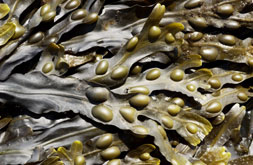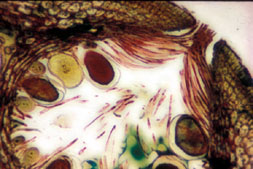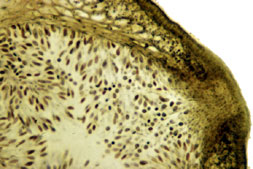Fucus
Fucus is northern-hemisphere genus of macroscopic marine seaweeds called wracks. It includes a relatively small number of species. Fucus vesiculosus is perhaps the best-known species (below), is known to have a number of useful compounds. The plants consist of a flattened, dichotomously-branched thallus which has a small stipe and a holdfast. The blade usually has a locally-thickened area which is centrally placed called a midrib. Air bladders are found in some species and these help to keep the plant afloat when submerged.
There is no conducting tissue in Fucus: it is unecessary as the plant is small enough to be able to manufacture food locally. In these brown algae the plants are always diploid and meiosis takes place before the gametes are formed. Gamete production takes place in specialised crypt-like structures called conceptacles which are borne in fertile, swollen areas at the tips of the plants: these are called receptacles. It is very easy to confuse these two terms. Some species of Fucus, such as Fucus spiralis, are monoecious with both sexes occurring on one plant; most are dioecious with each sex being found on different plants. Some monoecious species may have both sexes in one conceptacle whilst others may have them in separate conceptacles.

Oogonia, the female reproductive structures (below, in section), are bore on short stalks and after meiosis to form 8 nuclei (one meiosis and one mitosis) the oogonium then cleaves to form 8 large, non-motile eggs. Gametes are usually released into the water on the rising tide. Exposure to air causes dessication and the gametes are squeezed onto the surface of the receptacle, and are then washed off and mixed by the inoming tide. The female egg liberates a volatile hydrocarbon, fucoserraten (a compound with 8 carbon atoms) which attracts the male antherozoids; these cluster around the egg and spin it; one penetrates the complex series of coats around the egg and karyogamy (nuclear fusion) occurs. The zygotic cell settles down and germinates to form a new diploid thallus. Strictly speaking, the so-called gametophyte thallus in Fucus is a sporophyte that undergoes meiosis just before gametes are formed. This is the reason why some textbooks refer to the male gametangia as 'microsporangia' and the female gametangia as 'megasporangia'. Fucus species are found in the upper, mid, and lower intertidal in the colder waters of the northern Atlantic and northern Pacific. The genus is absent from the southern hemisphere.

The male reproductive structures (left, in section) are called antheridiophores which are branched, tree-like structures that line the conceptacles. The antheridiophores have terminal inflated antheridia on their branches; these undergo meiosis and form 64-128 biflagellate male gametes (antherozoids).
Examples

-
 BioAtlantis
provides sustainable technologies from the sea to enhance
plant, animal and human health.
BioAtlantis
provides sustainable technologies from the sea to enhance
plant, animal and human health.
-
 Connemara Organic Seaweed Company
provide hand harvested, sustainable, kelp and seaweed products
for human consumption through health supplements and edible
products.
Connemara Organic Seaweed Company
provide hand harvested, sustainable, kelp and seaweed products
for human consumption through health supplements and edible
products.
-
 Emerald Isle Organic Irish Seaweed.
A family business producing seaweed as supplements,
cooking, gardening and bath products.
Emerald Isle Organic Irish Seaweed.
A family business producing seaweed as supplements,
cooking, gardening and bath products.
-
 Irish Seaweeds Ltd
are suppliers of 100% natural hand-harvested seaweeds and
edible sea vegetable products from Ireland.
Irish Seaweeds Ltd
are suppliers of 100% natural hand-harvested seaweeds and
edible sea vegetable products from Ireland.
